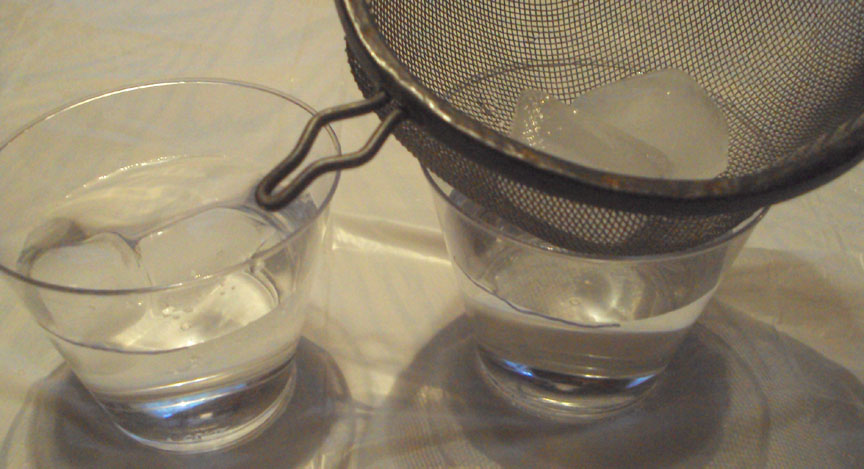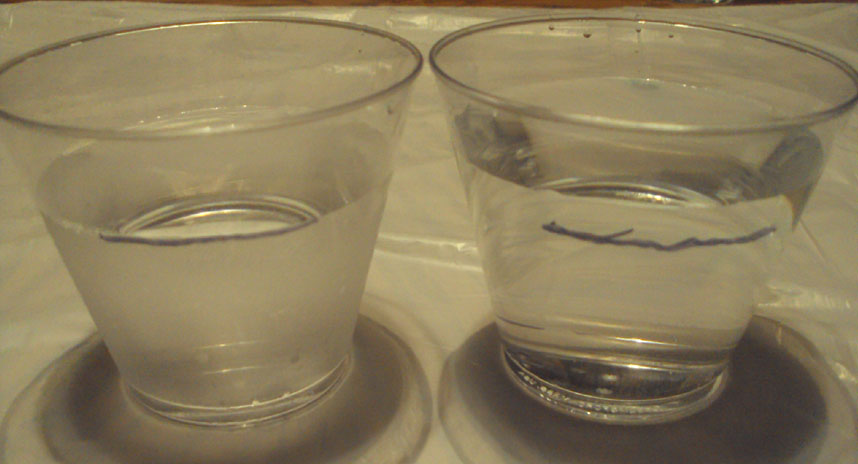Climate Change: Winners and Losers
Lesson 3: Melting Polar Ice
Page 1 Page 2 Page 3: Rising Sea Levels Review
Rising Sea Levels:
Here
is a map of the northern polar region: |
And
here is the southern polar region: |

. . . and let the ice cubes melt. Here is the result:

Notice how much more water is in the second cup? The reason for the difference is that in the first cup the ice was already in the water when it melted. Most of the volume of the ice was under the surface, already displacing the water. Only that small amount of ice sticking above the surface raised the water level of the cup as it melted. In the second cup, the ice cubes were outside of the cup, so when they melted all their water contributed to the rising water level.
In this case, it seems obvious--almost a no-brainer--that the location of the melting ice cubes would have an impact on how much the water level in the cup changed. But we need to keep this in mind when we try to predict how much sea levels will rise, because the location of the melting ice is critical.
In the northern polar regions, most of the ice is covering the Arctic Sea:

Even though there is a lot of ice, 90% of it is already below the surface of the ocean. Only the 10% that rises above the ocean can contribute to rising sea levels. If all the ice in the Arctic Sea melted, sea levels around the world would rise around 1 to 2 feet. But notice that Greenland is also covered with ice. This ice is currently on land. It is a glacier. If it melts, all the water from it will eventually wind up in the ocean. If the Greenland glacier melts completely, sea levels around the world will rise an additional 20 feet.
Now look at the southern polar region:

Almost all of the ice is on land, on the continent of Antarctica. Fortunately, the ocean currents circling Antarctica tend to isolate the continent's climate and keep it from warming. This suggests that Antarctica will probably be one of the last places on Earth to lose its ice cover. Antarctica will likely keep most of its water locked up as ice even after all the world's other glaciers and icecaps have melted.
And yet:
We know that Antarctica has been ice-free in the past despite its isolation. Knowing Earth's climate history, we can be pretty confident that Antarctica will be ice-free again someday. If global temperatures get high enough to melt all the ice on Antarctica, along with all the other ice caps and glaciers, then all bets are off. Sea levels will rise by as much as 230 feet (70m). Most of the world's major cities will be under water, and hundreds of millions of people will be displaced.
Here is a population map of the world:

The larger circles represent greater numbers of people. Notice how many of the world's largest circles are near shorelines? About 600 million people live in coastal areas that are less than 10m (~33ft.) above sea level. Imagine how many people will be affected if sea levels rise seven times that amount (70m, around 230 ft). As sea levels rise, more and more people will lose their land and their homes to flooding.
How devastating will this be? A lot depends on how rapidly this occurs. If the process takes 5,000 years, we can probably adjust to the changes. If it happens within 50 years, the results will be catastrophic. While it is probably not possible for all the ice covering Antarctica to melt that quickly, a lot will depend on the decisions that we make in the next few decades.
Melting glaciers and rising sea levels are only one of the consequences of putting too much greenhouse gas into our atmosphere. We will look at some additional challenges that we are likely face in our near future in the next lesson.
Go to Review